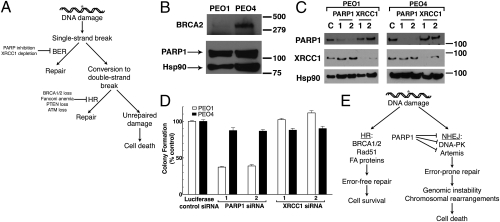Fig. 1.
PARP inhibitor synthetic lethality is independent of XRCC1 and BER. (A) Current model explaining synthetic lethality of PARP inhibition and HR deficiency. PARP inhibition is thought to induce accumulation of SSBs, which are converted to DSBs by collisions with replication machinery. The inability of HR-deficient cells to adequately repair DSBs results in genomic instability and eventual cell death. (B) Western blotting analysis of cell lysates from PEO1 and PEO4 cells. Blots were probed for BRCA2, PARP1, and Hsp90 (loading control). (C) Western blots demonstrating siRNA-mediated knockdown with luciferase (control), PARP1, or XRCC1 siRNA in PEO1 or PEO4 cells. (D) Clonogenic viability of cells from C after siRNA knockdown. After knockdown, cells were plated onto triplicate plates and allowed to form colonies. All results are reported as means of triplicate plates ± SEM and are representative of three independent experiments. (E) An alternate model of PARP inhibitor synthetic lethality centering on error-prone NHEJ. In this model, PARP1 catalytic activity regulates NHEJ activity, preventing NHEJ components from binding to sites of DNA damage or DNA ends. In the absence of HR and PARP activity, deregulated NHEJ aberrantly processes DNA and introduces chromosomal instability, leading to cell death.

